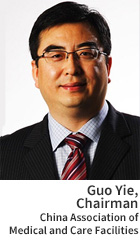Related Organizations
From the Chairman of the Japan Association of Medical and Care Facilities
On June 30, 2022 I was appointed chairperson of the Japan Association of Medical and Care Facilities. I still have much to learn, but I will do my utmost to fulfill the responsibilities of the position.
At the 30th annual meeting of the Japan Association of Medical and Care Facilities held at the Kyoto International Conference Center on November 17 and 18, 2022, at which I served as chairperson of the meeting, we were pleased to welcome Dr. Deok-jin Kim, the chairperson of the Korean Association of Medical and Care Facilities. Dr. Kim has contributed greatly to the international expansion and development of long-term medical care.
We are now approaching a third year of worldwide upheaval caused by the novel coronavirus, with no sign in sight that the virus is ebbing. Countries are seeking ways to counteract infections and at the same time keep their economies moving forward, while the medical world is exploring treatment approaches.
In 2025, the baby boomer generation in Japan will reach the elderly stage of life, which has necessitated changes in our medical and nursing care systems. Currently, however, we are facing a growing number of problems as we move toward 2040. Japan’s population largely reached a peak in 2010, and since then has been decreasing, with an especially sharp decrease in the working population. Even now, we are encountering a severe shortage of nursing staff. Rather than bemoaning the current situation, however, we need to work towards finding solutions. It will be important to find ways to increase the number of caregivers, but for those of us in the medical profession, I believe that it is our mission to reduce the volume of nursing care required by elderly members of society.
This means reducing the number of bedridden elderly people as much as possible. To do that, we will need to further enhance our rehabilitation services, and introduce nutritional management aimed at preventing frailty, along with other measures.
The Japan Association of Medical and Care Facilities advocates the employment of general practitioners who can provide holistic medical care in all medical settings, as well as introducing standard rehabilitation and standard nursing care. We believe that it is important to promote seamless systems that eliminate barriers to medical and nursing care in both acute-phase and chronic-phase medical care.
As the first country in the world to experience a super-aged society, Japan must set an example for the rest of the world by building medical and welfare systems that will enable its citizens to lead fulfilling lives with peace of mind. Our aim is to then use this know-how to deepen our links and connections with people in Asian countries and contribute to further development.
Click here for the website of the Japan Association of Medical and Care Facilities.

From the Chairman of the Korean Association of Medical Care and Facilities
Falling birthrates and aging populations are problems that extend beyond Japan, which has the world’s longest longevity rate, and other advanced nations. Similar challenges are being seen in Asian countries, which are undergoing remarkable development as global centers of growth. More specifically, we expect to see societal aging in East Asia occur at a pace unlike that seen anywhere else in the world.
As our populations age, we are seeing growing medical needs as well, and we need to not only review medical care aimed at treating conventional illnesses, but at the same time to explore new approaches to medical care and healthcare systems. This is vital not only in terms of forecasting future directions in medical care that will enable independent lives for elderly residents, but is crucially important in order to identify ways to work with other countries and build a foundation for high-quality long-term medical care. In so doing, we hope to conquer issues that we have in common with other Asian nations facing aging societies.
Given this necessity, the Korean Association of Medical and Care Facilities was created for the purpose of helping the elderly achieve autonomous health care. To this end, we are seeking out a new international framework for providing advanced long-term medical care and defining issues that Asian nations share in common, such as geriatric medical care, healthcare policies, and related systems, and are pursuing specific measures for solving these issues through a comprehensive approach.
We also hope to discuss additional ways in which to deepen ties between different regions and countries, and to foster a spirit of goodwill and solidarity among Asian nations. At the same time, we will be working to forge long-term medical care networks that transcend borders, and to work together with our member nations to create an epic vision of where we want to go.
Click here for the website of the Korean Association of Medical Care and Facilities.

From the Chairman of the China Association of Medical Care and Facilities
In step with the rapid growth of China’s economy, the Chinese people are seeing an ongoing upturn in the level of their lifestyle. Rather than simply seeking to reach the average lifespan, Chinese have moved on to strive for higher quality of life, with the aim of enjoying good health and remaining active throughout their entire lives. As a result, post-acute medical care is now a focus of intense interest across a broad spectrum.


